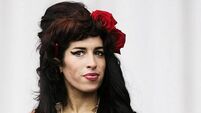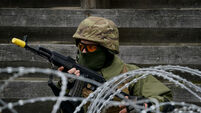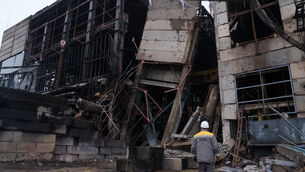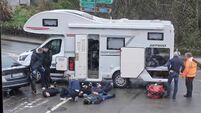Monks resume protests despite government warnings
Buddhist monks spearheading Burma's biggest anti-government marches in nearly two decades defied orders from the military junta to stay out of politics and relaunched their protests in the country's two biggest cities today.
About 4,000 monks, cheered on by several thousand supporters, gathered for the eighth day of peaceful protest at Rangoon's soaring Shwedagon Pagoda, while some 700 marched in the country's second largest city of Mandalay.
The demonstrations came despite orders to the Buddhist clergy to halt all political activity and return to their monasteries, and as pro-junta supporters in pick-up trucks cruised Rangoon warning that large crowds were illegal.
The protests in Rangoon reached 100,000 yesterday, becoming the biggest demonstrations since a pro-democracy uprising 19 years ago.
The authorities did not stop the protests, even as they built to a scale and fervour that rivalled the 1988 uprising when the military fired on peaceful crowds and killed thousands, terrorising the country.
The government has been handling the monks gingerly, wary of angering ordinary citizens in this devout, predominantly Buddhist nation.
But diplomats said troops have been discreetly deployed in downtown Rangoon and could easily be called in against the protesters. Some schools in the capital were closed.
Following yesterday's march, authorities in cars cruised Rangoon's streets today, announcing that the clergy have been directed not to take part in "secular affairs" and saying that certain elements were trying to instigate unrest in the country.
Warnings were also sent out against all illegal gatherings in a country where an assembly of more than five can amount to breaking the law.
The government's New Light of Myanmar newspaper quoted Religious Affairs Minister Brigadier General Thura Myint Maung as saying that protests by monks had also spread to cities like Mandalay, Hinthada and Monywa in seven of the country's 14 states and divisions.
The demonstrations have escalated in just one week from a marginalised movement to mass protests, drawing not only the monks but people from all walks of life.
In Mandalay, ordinary people were starting to join the monks or follow them on foot, motorcycles, bicycles and trishaws, although many still appeared too afraid to show their open support.
"I support the monks. However, if I join them, the government will arrest me," said a man selling belts at a Mandalay market. He declined to give his name, fearing reprisals from officials.
The head of the country's official Buddhist organisation, or Sangha, issued a directive yesterday ordering monks to stick to just learning and propagating the faith, saying young monks were being "compelled by a group of destructive elements within and without to break the law", the newspaper said.
These agitators included members of the pro-democracy National League of Democracy, led by Aung San Suu Kyi, remnants of the defunct Burmese Communist Party and some foreign radio stations, the minister was quoted as saying.
"The authorities concerned are handling the current situation with care and the least mistakes," the minister said.
Following yesterday's Rangoon protest, led by a phalanx of barefoot monks, the US was poised to impose additional sanctions against Burma's military rulers.
US President George Bush was to announce the sanctions against key members of the junta and those who provide them financial aid in a speech at the UN General Assembly, the White House said.













